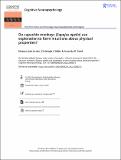Files in this item
Do capuchin monkeys (Sapajus apella) use exploration to form intuitions about physical properties?
Item metadata
| dc.contributor.author | Jordan, Eleanor | |
| dc.contributor.author | Voelter, Christoph Johannes | |
| dc.contributor.author | Seed, Amanda Madeleine | |
| dc.date.accessioned | 2022-06-23T14:30:08Z | |
| dc.date.available | 2022-06-23T14:30:08Z | |
| dc.date.issued | 2022-06-22 | |
| dc.identifier | 280019458 | |
| dc.identifier | 0910b1b1-5166-4c40-91a9-f47dc92ff20e | |
| dc.identifier | 000814690800001 | |
| dc.identifier | 85132736937 | |
| dc.identifier.citation | Jordan , E , Voelter , C J & Seed , A M 2022 , ' Do capuchin monkeys ( Sapajus apella ) use exploration to form intuitions about physical properties? ' , Cognitive Neuropsychology , vol. Latest Articles . https://doi.org/10.1080/02643294.2022.2088273 | en |
| dc.identifier.issn | 0264-3294 | |
| dc.identifier.other | ORCID: /0000-0002-3867-3003/work/114977638 | |
| dc.identifier.uri | https://hdl.handle.net/10023/25560 | |
| dc.description | We are grateful to the Royal Zoological Society of Scotland (RZSS) and the University of St Andrews for core financial support to the RZSS Edinburgh Zoo’s Living Links Research Facility where this project was carried out. | en |
| dc.description.abstract | Humans’ flexible innovation relies on our capacity to accurately predict objects’ behaviour. These predictions may originate from a “physics-engine” in the brain which simulates our environment. To explore the evolutionary origins of intuitive physics, we investigate whether capuchin monkeys’ object exploration supports learning. Two capuchin groups experienced exploration sessions involving multiple copies of two objects, one object was easily opened (functional), the other was not (non-functional). We used two within-subject conditions (enrichment-then-test, and test-only) with two object sets per group. Monkeys then underwent individual test sessions where the objects contained rewards, and they choose one to attempt to open. The monkeys spontaneously explored, performing actions which yielded functional information. At test, both groups chose functional objects above chance. While high performance of the test-only group precluded us from establishing learning during exploration, this study reveals the promise of harnessing primates’ natural exploratory tendencies to understand how they see the world. | |
| dc.format.extent | 13 | |
| dc.format.extent | 2204007 | |
| dc.language.iso | eng | |
| dc.relation.ispartof | Cognitive Neuropsychology | en |
| dc.subject | Exploration | en |
| dc.subject | Curiosity | en |
| dc.subject | Physical cognition | en |
| dc.subject | Learning | en |
| dc.subject | Capuchin monkeys | en |
| dc.subject | BF Psychology | en |
| dc.subject | NDAS | en |
| dc.subject.lcc | BF | en |
| dc.title | Do capuchin monkeys (Sapajus apella) use exploration to form intuitions about physical properties? | en |
| dc.type | Journal article | en |
| dc.contributor.institution | University of St Andrews. School of Psychology and Neuroscience | en |
| dc.contributor.institution | University of St Andrews. Institute of Behavioural and Neural Sciences | en |
| dc.contributor.institution | University of St Andrews. ‘Living Links to Human Evolution’ Research Centre | en |
| dc.contributor.institution | University of St Andrews. Centre for Social Learning & Cognitive Evolution | en |
| dc.identifier.doi | https://doi.org/10.1080/02643294.2022.2088273 | |
| dc.description.status | Peer reviewed | en |
This item appears in the following Collection(s)
Items in the St Andrews Research Repository are protected by copyright, with all rights reserved, unless otherwise indicated.

